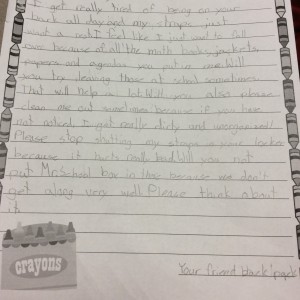 I see lesson plans everywhere! I have always been the teacher that goes somewhere, looks at something, picks up a book and can think of ways to bring it into the classroom as a lesson. A friend once commented, “It does not matter where we go you think of a way to teach kids.”
I see lesson plans everywhere! I have always been the teacher that goes somewhere, looks at something, picks up a book and can think of ways to bring it into the classroom as a lesson. A friend once commented, “It does not matter where we go you think of a way to teach kids.”
There is a paper trail in lesson planning as well. I remember learning the format in college. Lessons were centered around a book or activity. There was an anticipatory set; grab their attention! Objectives were written “SWBAT…” with explicit instructions to the teacher. Wrap up with an assessment and the list of ways to modify the lesson for those above and below grade level. I files still with these typed (yep, like on a typewriter typed) lesson plans. And they have sat in my binder ever since.
Each week my team discusses our standards and lessons for the week. We look through the math teacher’s manual, vocabulary and key ideas for science and social studies, discuss the writing trait and review the comprehension strategies. I have a template I use to type in the standards, key ideas and teacher manual pages. The real lessons come alive as I teach.
Mentor, Lori Rice–This week Lauren (my student intern) is teaching her first lesson. I have spent more time commenting on, discussing and guiding her on this one lesson that I spend writing my entire week of lessons. Again, I am enjoying the push this gives me to think through all the steps of a lesson. It is second nature, almost like breathing to me; and yet here I get to slow down and really think about each part of a quality lesson. There is an art and a science involved in planning as well as presenting a lesson that is engaging to all learners.
Lesson plan formats vary. The important details are to include your objectives, materials, think through the process and know how you will assess the learning. Questioning and classroom management are, in my opinion, the two biggest components in a successful lesson. If you are able to ask students higher level questions you can guide them in learning. You also nourish and build upon the inherent curiosity of children. I have noticed the level of questioning in Lauren’s lesson are focusing on basic questions. This gives us a teaching point and something for her to use as a personal goal. Along with having control of a lesson, questioning allows you to build the learning as it grows.
Intern, Lauren Laudan–“Standards, objectives, anticipatory set, adaptations, formative assessment,” to any
teacher this is normal lingo. But, for the rest of the world, these words probably seem like jargon. Throughout my pre-service teaching classes, I was often under the impression that teaching is very similar to performing a play. It was a word for word script where everything that was going to (well supposed to) happen was already planned out. How convenient would life be if we knew everything was going to happen exactly as we planned?! Unfortunately, life doesn’t work that way and teaching is no different.
Planning my first lesson I focused on writing down the most important “things”. For example, “Students will hear an example of strong voice in the story The Day the Crayons Quit and will select an object and write from the perspective of that object.” This one sentence told me exactly what my purpose was for teaching my lesson. It also told me what students will do in order to practice their newly learned skill of voice in writing. Of course, a lot more goes into writing a good lesson plan, but this was step one.
I knew as I went to pick the kids up from music that the moment we stepped back into the classroom all eyes would be on me. This was my first “official” time being in charge; Lori was taking the back seat and giving me full control as I taught my writing lesson to our 24 eager-to-learn fourth graders. The first few minutes of any lesson are the most nerve wrecking and all I kept thinking was, “Are the kids going to be interested and engaged?” “Is my lesson too difficult? Too easy?” After the first five minutes my nerves eased and I am glad to say my students loved the book (which is one of my personal favorites). Their enthusiastic hands assured me they were engaged and staying with me.
Mentor, Lori Rice–I felt freedom as I stopped by the office before the students were picked up from music. My 35 minute plan time is never enough, but today I did not have to be “on” again until after lunch. Lauren was in charge of the next lesson. My role was observing her for feedback and assisting as needed. I wish every teacher had the gift of two teacher in a classroom. It is freeing to know the responsibility is shared.
Intern, Lauren Laudan–Taking the lead allowed me to see things from a new perspective; one in which I was no
longer an “observer” or “co-teacher” in the room. I presented the lesson the way I wanted and as any educator knows, flexibility was the key. When I noticed my students needed more practice remembering what voice was, we paused and went back to review. It can be hard to deviate from a lesson plan, but it is also crucial for learning.
I’m glad to report that we all made it out alive and I absolutely loved reading what the students wrote and having to “guess” what object voice they had become. Using the book The Day the Crayons Quit as a mentor text, students wrote creative and engaging pieces practicing the trait of voice.
Mentor, Lori Rice–It is interesting to watch someone else lead your class. As Lauren began teaching, I was able to observe my students in a new light. I enjoyed watching her lesson develop and she did a nice job reading aloud. I could tell she was aware of the students as she tried to be sure they could all see the book. It was funny when she skipped part 5 in her lesson plans (she quickly mentioned this when we reflected together). This step was to ask questions after the story. She was focused on the writing activity and went straight to that. And then as the students work time began I was able to wander and look at what they were truly doing. My focus was away from my responsibly and instead was on my students. I am excited how this experience is going to open up my time to help my kids more.
There are so many things a teacher does in a lesson. I am surprised by the information she has used in lesson planning that she was taught in her college classes, and the direct instruction she needs to implement these ideas into our classroom. Clearly stating learning objectives and student expectations along with higher level questioning are two areas we will be focusing on. There is a difference in knowing what you want students to do and effectively communicating that to your students. Watching her first lesson I am excited to be on this journey and watch her growth.
Student Intern, Lauren Laudan– As you can see from the example, the students embraced their imagination and creativity. As a teacher it is neat to see students get excited about writing, especially when itʼs focused on a skill they just recently learned. Although their writing was an activity that was not formally assessed, students were very successful and I look forward to continuing to get to watch their writing develop and their voices come through.
However, every lesson requires reflection and as a student intern there is always room for growth and change (and thankfully many future lessons to practice these skills). I am grateful for the constructive feedback I received from Lori and am excited to put into practice the suggestions she gave me. For example, “Longer wait time with questioning”, “Stop at least two to three times throughout the read-aloud to ensure students are comprehending” and “Convey to the students explicit expectations.” I agree with each one of those.
Even after being in school for six months kids need those reminders. Lori has made the decision to use the CHAMPS method with her class so the students know exactly what is expected of them at all times. CHAMPS is new to me and something I am still trying to get the hang of using in class. However, I have already seen the students react very well to this method of classroom management and so I plan to continue to practice this method each time I teach. As teachers it is important that we figure out what works with our group of kids and stick to it. Our students need routine.
One of my students later that day asked me, “So are you like… the new Ms. Rice?” Although I am not the “new Ms. Rice” I think this lesson gave students the chance to truly grasp why I have recently become a member their class and they are beginning to open up and trust me more and more.





Leave a comment